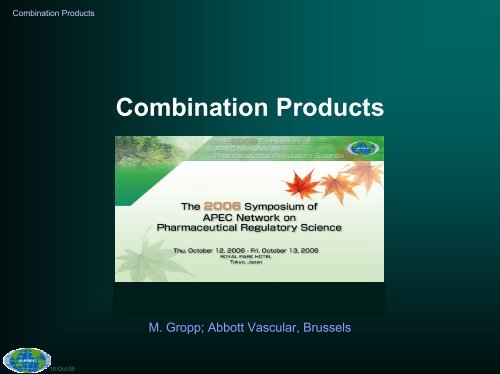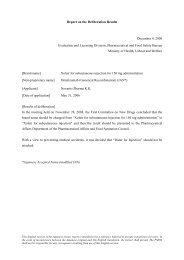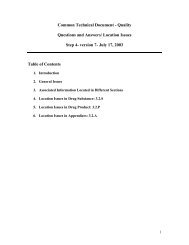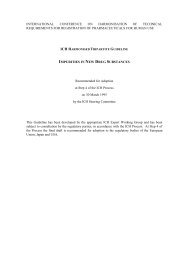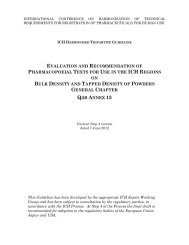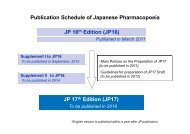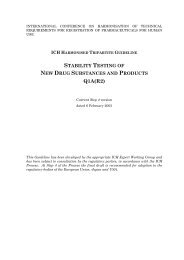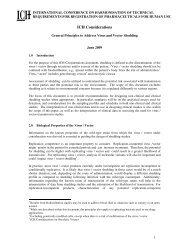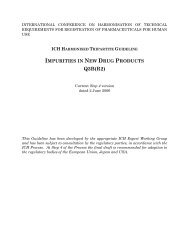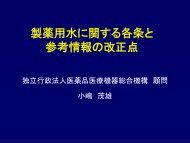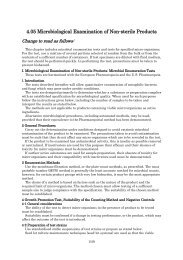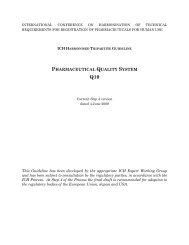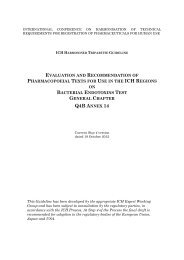Combination Products and Asia Regional Medical Device ...
Combination Products and Asia Regional Medical Device ...
Combination Products and Asia Regional Medical Device ...
Create successful ePaper yourself
Turn your PDF publications into a flip-book with our unique Google optimized e-Paper software.
<strong>Combination</strong> <strong>Products</strong><br />
<strong>Combination</strong> <strong>Products</strong><br />
M. Gropp; Abbott Vascular, Brussels<br />
18-Oct-06
<strong>Combination</strong> <strong>Products</strong><br />
Caveats<br />
• Complex topics<br />
• Focus mostly on device-drug combinations, but<br />
similar considerations apply to other combination<br />
products<br />
• Taken from medical device perspective<br />
• Personal views<br />
18-Oct-06<br />
APEC Tokyo 2006 <strong>Combination</strong> <strong>Products</strong> <strong>and</strong> <strong>Asia</strong>n Harmonization; M. Gropp<br />
2
<strong>Combination</strong> <strong>Products</strong><br />
Source: About APEC, APEC Secretariat, 2004<br />
18-Oct-06<br />
APEC Tokyo 2006 <strong>Combination</strong> <strong>Products</strong> <strong>and</strong> <strong>Asia</strong>n Harmonization; M. Gropp<br />
3
<strong>Combination</strong> <strong>Products</strong><br />
Source: APEC At a Glance, APEC Secretariat, 2006<br />
18-Oct-06<br />
APEC Tokyo 2006 <strong>Combination</strong> <strong>Products</strong> <strong>and</strong> <strong>Asia</strong>n Harmonization; M. Gropp<br />
4
<strong>Combination</strong> <strong>Products</strong><br />
What is a “medical device”<br />
18-Oct-06<br />
APEC Tokyo 2006 <strong>Combination</strong> <strong>Products</strong> <strong>and</strong> <strong>Asia</strong>n Harmonization; M. Gropp<br />
5
<strong>Combination</strong> <strong>Products</strong><br />
What is a “medical device”<br />
USA definition:<br />
“… an instrument, apparatus, implement, machine, contrivance,<br />
implant, in vitro reagent, or other similar or related article,<br />
including any component, part, or accessory, which is —<br />
(1) recognized in the official National Formulary, or the United<br />
States Pharmacopeia, or any supplement to them,<br />
(2) intended for use in the diagnosis of disease or other<br />
conditions, or in the cure, mitigation, treatment, or<br />
prevention of disease, in man or other animals, or<br />
(3) intended to affect the structure or any function of the<br />
body of man or other animals, …<br />
Source: 21 U.S.C. 201(h)<br />
18-Oct-06<br />
APEC Tokyo 2006 <strong>Combination</strong> <strong>Products</strong> <strong>and</strong> <strong>Asia</strong>n Harmonization; M. Gropp<br />
6
<strong>Combination</strong> <strong>Products</strong><br />
What is a “medical device”<br />
USA definition (continued):<br />
“… <strong>and</strong> which does not achieve its primary intended<br />
purposes through chemical action within or on the body of<br />
man or other animals <strong>and</strong> which is not dependent upon being<br />
metabolized for the achievement of its primary intended<br />
purposes.” [Emphasis added]<br />
Source: 21 U.S.C. 201(h)<br />
18-Oct-06<br />
APEC Tokyo 2006 <strong>Combination</strong> <strong>Products</strong> <strong>and</strong> <strong>Asia</strong>n Harmonization; M. Gropp<br />
7
<strong>Combination</strong> <strong>Products</strong><br />
What is a “medical device”<br />
European Union definition:<br />
“… any instrument, apparatus, appliance, material or other<br />
article, whether used alone or in combination, including the<br />
software necessary for its proper application intended by the<br />
manufacturer to be used for human beings for the purpose of:<br />
- diagnosis, prevention, monitoring, treatment or<br />
alleviation of disease,<br />
- diagnosis, monitoring, treatment, alleviation of or<br />
compensation for an injury or h<strong>and</strong>icap,<br />
- investigation, replacement or modification of the<br />
anatomy or of a physiological process,<br />
- control of conception, …<br />
Source: Council Directive 93/42/EEC of 14 June 1993 concerning medical devices<br />
18-Oct-06<br />
APEC Tokyo 2006 <strong>Combination</strong> <strong>Products</strong> <strong>and</strong> <strong>Asia</strong>n Harmonization; M. Gropp<br />
8
<strong>Combination</strong> <strong>Products</strong><br />
What is a “medical device”<br />
European Union definition (continued):<br />
“… <strong>and</strong> which does not achieve its principal intended action<br />
in or on the human body by pharmacological,<br />
immunological or metabolic means, but which may be<br />
assisted in its function by such means” [Emphasis added]<br />
Source: Council Directive 93/42/EEC of 14 June 1993 concerning medical devices<br />
18-Oct-06<br />
APEC Tokyo 2006 <strong>Combination</strong> <strong>Products</strong> <strong>and</strong> <strong>Asia</strong>n Harmonization; M. Gropp<br />
9
<strong>Combination</strong> <strong>Products</strong><br />
What is a “medical device”<br />
Japan definition:<br />
( 定 義 ) 第 2 条<br />
4.この 法 律 で「 医 療 機 器 」とは、 人 若 しくは 動 物 の 疾 病 の 診 断 、 治 療 若<br />
しくは 予 防 に 使 用 されること、 又 は 人 若 しくは 動 物 の 身 体 の 構 造 若<br />
しくは 機 能 に 影 響 を 及 ぼすこと が 目 的 とされている 機 械 器 具 等 で<br />
あって、 政 令 で 定 めるものをいう。<br />
“equipments, instruments etc. specified by the government<br />
ordinance which are intended for use in the diagnosis,<br />
treatment or prevention of disease in humans or animals, or<br />
intended to affect the structure <strong>and</strong> functions of the human<br />
or animal body” [Emphasis added]<br />
Source: The Pharmaceutical Affairs Law; Law No. 145, dated Aug. 10, 1960, as amended by Law No. 73, dated June 11, 2003<br />
18-Oct-06<br />
APEC Tokyo 2006 <strong>Combination</strong> <strong>Products</strong> <strong>and</strong> <strong>Asia</strong>n Harmonization; M. Gropp<br />
10
<strong>Combination</strong> <strong>Products</strong><br />
What is a “medical device”<br />
Global Harmonization Task Force (GHTF) definition:<br />
“… any instrument, apparatus, implement, machine, appliance,<br />
implant, in vitro reagent or calibrator, software, material or other<br />
similar or related article:<br />
a) intended by the manufacturer to be used, alone or in<br />
combination, for human beings for one or more of the specific<br />
purpose(s) of:<br />
• Diagnosis, prevention, monitoring, treatment or<br />
alleviation of disease<br />
• Diagnosis, monitoring, treatment, alleviation of or<br />
compensation for an injury,<br />
• Investigation, replacement, modification, or support of<br />
the anatomy or of a physiological process …”<br />
Source: GHTF/SG1/N29R16:2005; Information Document Concerning the Definition of the Term “<strong>Medical</strong> <strong>Device</strong>”<br />
18-Oct-06<br />
APEC Tokyo 2006 <strong>Combination</strong> <strong>Products</strong> <strong>and</strong> <strong>Asia</strong>n Harmonization; M. Gropp<br />
11
<strong>Combination</strong> <strong>Products</strong><br />
What is a “medical device”<br />
GHTF definition (continued):<br />
• supporting or sustaining life<br />
• control of conception,<br />
• disinfection of medical devices,<br />
• providing information for medical or diagnostic purposes by<br />
means of in vitro examination of specimens derived from the<br />
human body<br />
<strong>and</strong><br />
b) which does not achieve its primary intended action in or<br />
on the human body by pharmacological, immunological<br />
or metabolic means, but which may be assisted in its<br />
intended function by such means” [Emphasis added]<br />
Source: GHTF/SG1/N29R16:2005; Information Document Concerning the Definition of the Term “<strong>Medical</strong> <strong>Device</strong>”<br />
18-Oct-06<br />
APEC Tokyo 2006 <strong>Combination</strong> <strong>Products</strong> <strong>and</strong> <strong>Asia</strong>n Harmonization; M. Gropp<br />
12
<strong>Combination</strong> <strong>Products</strong><br />
What is a “medical device”<br />
Source: US FDA CDRH 2005 Strategic Plan<br />
18-Oct-06<br />
APEC Tokyo 2006 <strong>Combination</strong> <strong>Products</strong> <strong>and</strong> <strong>Asia</strong>n Harmonization; M. Gropp<br />
13
<strong>Combination</strong> <strong>Products</strong><br />
What is a “medical device”<br />
• <strong>Medical</strong> devices distinguished from drugs <strong>and</strong><br />
biological products on basis of intended mode(s) of<br />
action<br />
• Not metabolic, pharmacologic, or immunologic<br />
• May be assisted by such means<br />
• Internationally harmonised definition exists<br />
• Not yet uniformly adopted<br />
• Opportunity for international harmonisation<br />
• No international definition of products that may cross<br />
borderlines<br />
• Opportunity for international harmonisation<br />
18-Oct-06<br />
APEC Tokyo 2006 <strong>Combination</strong> <strong>Products</strong> <strong>and</strong> <strong>Asia</strong>n Harmonization; M. Gropp<br />
14
<strong>Combination</strong> <strong>Products</strong><br />
Drugs <strong>and</strong> medical devices differ<br />
Drugs<br />
• Discovered<br />
• Stable formulation<br />
developed<br />
• Highly mechanised<br />
manufacture<br />
• Consumed by use<br />
• Systemic toxicity<br />
• Large populations of<br />
exposure<br />
• Patient may choose to stop<br />
use<br />
<strong>Medical</strong> devices<br />
• Designed<br />
• Constant iterative<br />
improvements or changes<br />
• Often manufactured by h<strong>and</strong><br />
operations<br />
• Available for study after use<br />
• Adverse events most often<br />
local in nature<br />
• Relatively limited populations<br />
of exposure<br />
• Generally not subject to<br />
ethnic differences<br />
• Most intended for<br />
professional use<br />
Source: S. Alpert, M.D., PhD. (Medtronic Corp.); <strong>Asia</strong>n Harmonization Working Party, Seoul, Sept. 2006 (adapted)<br />
18-Oct-06<br />
APEC Tokyo 2006 <strong>Combination</strong> <strong>Products</strong> <strong>and</strong> <strong>Asia</strong>n Harmonization; M. Gropp<br />
15
<strong>Combination</strong> <strong>Products</strong><br />
Drugs <strong>and</strong> medical devices differ<br />
Drugs<br />
• Pure molecules<br />
• Toxicology<br />
• Short half-life in body<br />
• Long market life<br />
• Drug interactions<br />
• Wrong drug/dose<br />
• Clinically studied<br />
• Good Manufacturing practice<br />
(cGMP)<br />
<strong>Medical</strong> devices<br />
• Complex components <strong>and</strong><br />
assemblages<br />
• Biocompatibility<br />
• Durable<br />
• Rapid product cycles<br />
• <strong>Device</strong> malfunction<br />
• Use error<br />
• Often bench studied<br />
• Quality management<br />
systems (ISO 9000 ISO<br />
13485)<br />
Source: D. Schultz, US FDA CDRH; Development of New Technology <strong>and</strong> Challenges to Regulatory Harmonization;<br />
APEC 2005, Taipei, Nov. 2005 (adapted)<br />
18-Oct-06<br />
APEC Tokyo 2006 <strong>Combination</strong> <strong>Products</strong> <strong>and</strong> <strong>Asia</strong>n Harmonization; M. Gropp<br />
16
<strong>Combination</strong> <strong>Products</strong><br />
Addressing unmet clinical needs<br />
Interventional<br />
pulmonology -<br />
emphysema<br />
Neurostimulation<br />
-pain<br />
-Incontinence<br />
-obesity<br />
18-Oct-06<br />
Neuroprosthesis –<br />
cochlear implant<br />
Microsurgical implant -<br />
glaucoma<br />
Sleep apnea devices<br />
Stomach<br />
implants -<br />
obesity<br />
Artificial<br />
pancreas,<br />
glucose sensors<br />
Source: Guidant Corporation; Oct. 2002<br />
Artificial spine<br />
disc<br />
Deep brain stimulation –<br />
Parkinson’s, tremor<br />
Neuroprosthesis –<br />
retinal stimulation<br />
APEC Tokyo 2006 <strong>Combination</strong> <strong>Products</strong> <strong>and</strong> <strong>Asia</strong>n Harmonization; M. Gropp<br />
Advanced catheter technology –<br />
Alzheimer’s<br />
Percutaneous valve repair<br />
VADs<br />
Diastolic Limiters<br />
Ventricular sourcing<br />
Atrial appendage plug<br />
AF devices, ablation<br />
Tissue engineering<br />
RF ablation – oncology<br />
Minimally invasive,<br />
transcervical, permanent<br />
contraception<br />
Intravascular temperature<br />
mgmt for AMI, stroke<br />
17
<strong>Combination</strong> <strong>Products</strong><br />
What is a “medical device”<br />
Source: Eucomed (modified)<br />
18-Oct-06<br />
APEC Tokyo 2006 <strong>Combination</strong> <strong>Products</strong> <strong>and</strong> <strong>Asia</strong>n Harmonization; M. Gropp<br />
18
<strong>Combination</strong> <strong>Products</strong><br />
What is a “medical device”<br />
Source: Nikkei Weekly 20 Feb. 2006<br />
18-Oct-06<br />
APEC Tokyo 2006 <strong>Combination</strong> <strong>Products</strong> <strong>and</strong> <strong>Asia</strong>n Harmonization; M. Gropp<br />
19
<strong>Combination</strong> <strong>Products</strong><br />
What is a “medical device”<br />
Source: Eucomed (modified)<br />
18-Oct-06<br />
APEC Tokyo 2006 <strong>Combination</strong> <strong>Products</strong> <strong>and</strong> <strong>Asia</strong>n Harmonization; M. Gropp<br />
20
<strong>Combination</strong> <strong>Products</strong><br />
What is a “medical device”<br />
Source: Eucomed (modified)<br />
18-Oct-06<br />
APEC Tokyo 2006 <strong>Combination</strong> <strong>Products</strong> <strong>and</strong> <strong>Asia</strong>n Harmonization; M. Gropp<br />
21
<strong>Combination</strong> <strong>Products</strong><br />
What is a “medical device”<br />
A major application of<br />
nanotechnology may be the<br />
targeted delivery of drugs to<br />
specific organs or tissues, e.g.<br />
for the treatment of cancers at<br />
their site rather than the use of<br />
systemic <strong>and</strong> often highly toxic<br />
chemotherapy<br />
Another possible application<br />
could be the delivery to<br />
specific sites of coated<br />
nanoparticles that could then<br />
be heated using intense light<br />
thereby destroying diseased<br />
tissue <strong>and</strong> cells<br />
Source: Eucomed (modified)<br />
18-Oct-06<br />
APEC Tokyo 2006 <strong>Combination</strong> <strong>Products</strong> <strong>and</strong> <strong>Asia</strong>n Harmonization; M. Gropp<br />
22
<strong>Combination</strong> <strong>Products</strong><br />
What is a “medical device”<br />
Some researchers postulate<br />
that synthetic “respirocytes”<br />
could augment oxygen supply<br />
to poorly vascularised tissues<br />
Measuring 1 micron in<br />
diameter, it has been<br />
suggested that these could<br />
pump 236 times more oxygen<br />
to tissue than a red blood cell<br />
They could also include an<br />
onboard nanocomputer <strong>and</strong><br />
chemical <strong>and</strong> pressure sensors<br />
Source: Eucomed (modified)<br />
18-Oct-06<br />
APEC Tokyo 2006 <strong>Combination</strong> <strong>Products</strong> <strong>and</strong> <strong>Asia</strong>n Harmonization; M. Gropp<br />
23
<strong>Combination</strong> <strong>Products</strong><br />
What is a “medical device”<br />
An example of human tissue-engineered cartilage intended to replace<br />
damaged cartilage as shown in the radiographic image<br />
Source: Eucomed (modified)<br />
18-Oct-06<br />
APEC Tokyo 2006 <strong>Combination</strong> <strong>Products</strong> <strong>and</strong> <strong>Asia</strong>n Harmonization; M. Gropp<br />
24
<strong>Combination</strong> <strong>Products</strong><br />
What is a “medical device”<br />
It is now becoming feasible to inject nano-encapsulated drugs, or metallic or semimetallic<br />
particles, into the T-lymphocyte which can be subsequently transported to<br />
a tumour site <strong>and</strong> there released or activated physically by an external source<br />
Source: Eucomed (modified)<br />
18-Oct-06<br />
APEC Tokyo 2006 <strong>Combination</strong> <strong>Products</strong> <strong>and</strong> <strong>Asia</strong>n Harmonization; M. Gropp<br />
25
<strong>Combination</strong> <strong>Products</strong><br />
What is a “medical device”<br />
Osteocytes growing on a spherical biopolymer scaffold (bottom of micrograph).<br />
Such products could typically be used in orthopaedic <strong>and</strong> reconstructive surgery<br />
Source: Eucomed (modified)<br />
18-Oct-06<br />
APEC Tokyo 2006 <strong>Combination</strong> <strong>Products</strong> <strong>and</strong> <strong>Asia</strong>n Harmonization; M. Gropp<br />
26
<strong>Combination</strong> <strong>Products</strong><br />
<strong>Combination</strong> products<br />
Japan METIS (<strong>Medical</strong> Engineering Technology<br />
Industrial Strategy Consortium)<br />
• Gene chips for diagnosis<br />
• Diagnosis <strong>and</strong> treatment with molecular imaging<br />
• DDS <strong>and</strong> target treatment<br />
• Minimally invasive treatment devices<br />
• Bionics medical equipment<br />
• Organ function assist device<br />
• Regenerative medical techniques for bone, cartilage,<br />
blood vessels, <strong>and</strong> cardiac muscles<br />
Source: Japan METIS; 5 Oct. 2005<br />
18-Oct-06<br />
APEC Tokyo 2006 <strong>Combination</strong> <strong>Products</strong> <strong>and</strong> <strong>Asia</strong>n Harmonization; M. Gropp<br />
27
<strong>Combination</strong> <strong>Products</strong><br />
Converging medical technologies<br />
Biologic<br />
Drug<br />
<strong>Device</strong><br />
18-Oct-06<br />
APEC Tokyo 2006 <strong>Combination</strong> <strong>Products</strong> <strong>and</strong> <strong>Asia</strong>n Harmonization; M. Gropp<br />
28
<strong>Combination</strong> <strong>Products</strong><br />
Converging medical technologies<br />
Biologic<br />
Drug<br />
<strong>Device</strong><br />
18-Oct-06<br />
APEC Tokyo 2006 <strong>Combination</strong> <strong>Products</strong> <strong>and</strong> <strong>Asia</strong>n Harmonization; M. Gropp<br />
29
<strong>Combination</strong> <strong>Products</strong><br />
What is a “combination product”<br />
<strong>Combination</strong>s of different types of regulated<br />
products<br />
• Drug – medical device<br />
• <strong>Medical</strong> device – biologic<br />
• Drug – biologic<br />
• Drug – medical device – biologic<br />
<strong>Combination</strong> products may be:<br />
• Physically or chemically combined (e.g., transdermal drug<br />
delivery)<br />
• Co-packaged in a kit<br />
• Separate, cross-labeled products (e.g., implantable pumps)<br />
Source: D. Schultz, US FDA CDRH; Development of New Technology <strong>and</strong> Challenges to Regulatory Harmonization;<br />
APEC 2005, Taipei, Nov. 2005<br />
18-Oct-06<br />
APEC Tokyo 2006 <strong>Combination</strong> <strong>Products</strong> <strong>and</strong> <strong>Asia</strong>n Harmonization; M. Gropp<br />
30
<strong>Combination</strong> <strong>Products</strong><br />
<strong>Combination</strong> products<br />
• One item composed of two or more products that are<br />
subject to different regulatory regimes<br />
• Two or more differently regulated items that must be<br />
used together to achieve the intended outcome<br />
• Often, but not always, packaged together<br />
• Labelled for required use together<br />
• Often offer unique therapeutic advantages<br />
• A regulatory challenge for regulators <strong>and</strong> industry<br />
Source: S. Alpert, M.D., PhD. (Medtronic Corp.); <strong>Asia</strong>n Harmonization Working Party, Seoul, Sept. 2006, <strong>and</strong> US FDA (adapted)<br />
18-Oct-06<br />
APEC Tokyo 2006 <strong>Combination</strong> <strong>Products</strong> <strong>and</strong> <strong>Asia</strong>n Harmonization; M. Gropp<br />
31
<strong>Combination</strong> <strong>Products</strong><br />
<strong>Combination</strong> products becoming more common<br />
<strong>Combination</strong> product applications US FDA<br />
Source: FY 2005 Performance Report to Congress; US FDA Office of <strong>Combination</strong> <strong>Products</strong><br />
18-Oct-06<br />
APEC Tokyo 2006 <strong>Combination</strong> <strong>Products</strong> <strong>and</strong> <strong>Asia</strong>n Harmonization; M. Gropp<br />
32
<strong>Combination</strong> <strong>Products</strong><br />
What is a “combination product”<br />
• “A product comprised of two or more regulated<br />
components … that are physically, chemically, or<br />
otherwise combined or mixed <strong>and</strong> produced as a<br />
single entity;<br />
• Two or more separate products packaged together in<br />
a single package or as a unit <strong>and</strong> comprised of drug<br />
<strong>and</strong> device products, device <strong>and</strong> biological products,<br />
or biological <strong>and</strong> drug products;<br />
• A drug, device, or biological product packaged<br />
separately that according to its … labeling is intended<br />
for use only with an … individually specified, drug,<br />
device or biological product where both are required<br />
to achieve the intended use, indication, or effect ….”<br />
Source: US FDA; 21 CFR § 3.2(e)<br />
18-Oct-06<br />
APEC Tokyo 2006 <strong>Combination</strong> <strong>Products</strong> <strong>and</strong> <strong>Asia</strong>n Harmonization; M. Gropp<br />
33
<strong>Combination</strong> <strong>Products</strong><br />
<strong>Combination</strong> products<br />
• In many economies, regulatory controls <strong>and</strong><br />
requirements for drugs, devices, <strong>and</strong> biological<br />
product are similar, but different<br />
• One approach does not suit all products<br />
• Pre- <strong>and</strong> post-market requirements differ<br />
• No special type of marketing application for<br />
combination products<br />
• Several regulatory authorities or components may<br />
have interest <strong>and</strong> expertise<br />
• Need clear rules for determining regulatory<br />
responsibility<br />
18-Oct-06<br />
APEC Tokyo 2006 <strong>Combination</strong> <strong>Products</strong> <strong>and</strong> <strong>Asia</strong>n Harmonization; M. Gropp<br />
34
<strong>Combination</strong> <strong>Products</strong><br />
<strong>Combination</strong> products regulatory considerations<br />
• How, <strong>and</strong> by whom, product will be used<br />
• Additive effects of other components<br />
• Entire life cycle of product should be considered<br />
• Product’s most important therapeutic benefit helps<br />
determine how to regulate<br />
18-Oct-06<br />
APEC Tokyo 2006 <strong>Combination</strong> <strong>Products</strong> <strong>and</strong> <strong>Asia</strong>n Harmonization; M. Gropp<br />
35
<strong>Combination</strong> <strong>Products</strong><br />
<strong>Combination</strong> products regulatory considerations<br />
• Mode of action: “… the means by which a product<br />
achieves an intended therapeutic effect or action. …<br />
“therapeutic” action or effect includes any effect or<br />
action of the combination product intended to<br />
diagnose, cure, mitigate, treat, or prevent disease, or<br />
affect the structure of any function of the body”<br />
Source: US FDA; 21 CFR 3.2 (k)<br />
18-Oct-06<br />
APEC Tokyo 2006 <strong>Combination</strong> <strong>Products</strong> <strong>and</strong> <strong>Asia</strong>n Harmonization; M. Gropp<br />
36
<strong>Combination</strong> <strong>Products</strong><br />
<strong>Combination</strong> products regulatory considerations<br />
• Primary mode of action: “… the single mode of<br />
action of a combination product that provides the<br />
most important therapeutic action of the combination<br />
product.<br />
The most important therapeutic action is the mode of<br />
action expected to make the greatest contribution to<br />
the overall intended therapeutic effects of the<br />
combination product”<br />
Source: US FDA; 21 CFR 3.2 (m)<br />
18-Oct-06<br />
APEC Tokyo 2006 <strong>Combination</strong> <strong>Products</strong> <strong>and</strong> <strong>Asia</strong>n Harmonization; M. Gropp<br />
37
<strong>Combination</strong> <strong>Products</strong><br />
Determining “primary mode of action”<br />
Source: US FDA Talk Paper, May 6, 2004 regarding proposed rule on combination products (http://www.fda.gov/bbs/topics/ANSWERS/2004/ANS01288.html)<br />
18-Oct-06<br />
APEC Tokyo 2006 <strong>Combination</strong> <strong>Products</strong> <strong>and</strong> <strong>Asia</strong>n Harmonization; M. Gropp<br />
38
<strong>Combination</strong> <strong>Products</strong><br />
<strong>Combination</strong> products regulatory objectives<br />
• Effective regulation of the combination – taking into<br />
account each contributing attribute<br />
• Risk-based <strong>and</strong> proportionate controls<br />
• Protect patients<br />
• Promote innovation<br />
• Scientifically appropriate assessments<br />
• Avoid repetitive or unnecessary reviews<br />
• Transparency of jurisdiction determinations,<br />
requirements <strong>and</strong> review pathways<br />
• Timely access of patients <strong>and</strong> clinicians to these<br />
important products<br />
18-Oct-06<br />
APEC Tokyo 2006 <strong>Combination</strong> <strong>Products</strong> <strong>and</strong> <strong>Asia</strong>n Harmonization; M. Gropp<br />
39
<strong>Combination</strong> <strong>Products</strong><br />
<strong>Combination</strong> products -- Summary<br />
• <strong>Combination</strong> products offer therapeutic benefits<br />
• <strong>Combination</strong> products pose challenges for regulators<br />
<strong>and</strong> industry<br />
• Regulatory differences derive from underlying<br />
product differences<br />
• Regulatory requirements <strong>and</strong> authorisation pathways<br />
should be consistent <strong>and</strong> predictable<br />
• Opportunity for international regulatory harmonisation<br />
• Important challenge for global product development<br />
<strong>and</strong> clinical trials<br />
18-Oct-06<br />
APEC Tokyo 2006 <strong>Combination</strong> <strong>Products</strong> <strong>and</strong> <strong>Asia</strong>n Harmonization; M. Gropp<br />
40
<strong>Combination</strong> <strong>Products</strong><br />
<strong>Asia</strong> <strong>Regional</strong> <strong>Medical</strong> <strong>Device</strong><br />
Regulatory Harmonization<br />
M. Gropp; Abbott Vascular, Brussels<br />
18-Oct-06
<strong>Combination</strong> <strong>Products</strong><br />
Caveats<br />
• Complex topic<br />
• General overview<br />
18-Oct-06<br />
APEC Tokyo 2006 <strong>Combination</strong> <strong>Products</strong> <strong>and</strong> <strong>Asia</strong>n Harmonization; M. Gropp<br />
42
<strong>Combination</strong> <strong>Products</strong><br />
What is regulatory “harmonization”<br />
• Progressive convergence over time of regulatory<br />
requirements <strong>and</strong> practices<br />
• Progressive elimination or reduction of technical<br />
differences in regulatory requirements<br />
► Facilitates global product development <strong>and</strong> clinical<br />
investigations<br />
18-Oct-06<br />
APEC Tokyo 2006 <strong>Combination</strong> <strong>Products</strong> <strong>and</strong> <strong>Asia</strong>n Harmonization; M. Gropp<br />
43
<strong>Combination</strong> <strong>Products</strong><br />
International medical device regional<br />
regulatory harmonization initiatives<br />
GHTF<br />
18-Oct-06<br />
APEC Tokyo 2006 <strong>Combination</strong> <strong>Products</strong> <strong>and</strong> <strong>Asia</strong>n Harmonization; M. Gropp<br />
44
<strong>Combination</strong> <strong>Products</strong><br />
Global Harmonization Task Force (GHTF)<br />
History<br />
• Informal grouping of medical device regulators <strong>and</strong><br />
industry<br />
• Began in 1992<br />
• Canada, European Union, Japan, USA<br />
– Australia joined in 1993<br />
– “Founding Members”<br />
– Other interested countries are “Participating<br />
Members”<br />
• Analogous to International Conference on<br />
Harmonization (ICH) in pharmaceutical sector<br />
18-Oct-06<br />
APEC Tokyo 2006 <strong>Combination</strong> <strong>Products</strong> <strong>and</strong> <strong>Asia</strong>n Harmonization; M. Gropp<br />
45
<strong>Combination</strong> <strong>Products</strong><br />
GHTF<br />
Purpose:<br />
“.... to encourage convergence in regulatory practices<br />
related to ensuring the safety, effectiveness /<br />
performance <strong>and</strong> quality of medical devices,<br />
promoting technological innovation <strong>and</strong> facilitating<br />
international trade ...”<br />
Source: GHTF<br />
18-Oct-06<br />
APEC Tokyo 2006 <strong>Combination</strong> <strong>Products</strong> <strong>and</strong> <strong>Asia</strong>n Harmonization; M. Gropp<br />
46
<strong>Combination</strong> <strong>Products</strong><br />
GHTF<br />
Purpose (cont’d):<br />
“.... the primary way in which this is accomplished is<br />
via the publication <strong>and</strong> dissemination of harmonized<br />
guidance documents on basic regulatory practices.<br />
These documents can then be adopted / implemented<br />
by member national regulatory authorities ...”<br />
• GHTF guidance substantially adopted in<br />
Australia, Canada, EU, <strong>and</strong> Japan<br />
Source: GHTF<br />
18-Oct-06<br />
APEC Tokyo 2006 <strong>Combination</strong> <strong>Products</strong> <strong>and</strong> <strong>Asia</strong>n Harmonization; M. Gropp<br />
47
<strong>Combination</strong> <strong>Products</strong><br />
GHTF<br />
Purpose (cont’d):<br />
“.... GHTF also serves as an information exchange<br />
forum through which countries with medical device<br />
regulatory systems under development can benefit<br />
from the experience of those with existing systems<br />
<strong>and</strong>/or pattern their practices upon those of GHTF<br />
founding members.”<br />
Source: GHTF<br />
18-Oct-06<br />
APEC Tokyo 2006 <strong>Combination</strong> <strong>Products</strong> <strong>and</strong> <strong>Asia</strong>n Harmonization; M. Gropp<br />
48
<strong>Combination</strong> <strong>Products</strong><br />
GHTF Organization Structure<br />
Steering Committee<br />
ISO, IEC, ITU<br />
WHO<br />
GMDN<br />
Study Group 1<br />
Regulatory systems<br />
Premarket assessment<br />
Study Group 2<br />
Vigilance reporting<br />
Market surveillance<br />
Study Group 3<br />
Quality system<br />
requirements<br />
Study Group 4<br />
Quality systems<br />
auditing<br />
Study Group 5<br />
Clinical evidence<br />
ISO TC/210<br />
ISO TC/194<br />
18-Oct-06<br />
APEC Tokyo 2006 <strong>Combination</strong> <strong>Products</strong> <strong>and</strong> <strong>Asia</strong>n Harmonization; M. Gropp<br />
49
<strong>Combination</strong> <strong>Products</strong><br />
GHTF guidance documents<br />
URL: http://www.ghtf.org<br />
Proposed <strong>and</strong> final guidance documents<br />
18-Oct-06<br />
APEC Tokyo 2006 <strong>Combination</strong> <strong>Products</strong> <strong>and</strong> <strong>Asia</strong>n Harmonization; M. Gropp<br />
50
<strong>Combination</strong> <strong>Products</strong><br />
Source: APEC<br />
18-Oct-06<br />
APEC Tokyo 2006 <strong>Combination</strong> <strong>Products</strong> <strong>and</strong> <strong>Asia</strong>n Harmonization; M. Gropp<br />
51
<strong>Combination</strong> <strong>Products</strong><br />
<strong>Asia</strong>: Emerging medical technology regulation<br />
* Current or expected<br />
medical device regulations<br />
*<br />
Source: AdvaMed <strong>and</strong> Eucomed<br />
*<br />
* <br />
<br />
*<br />
*<br />
* *<br />
*<br />
* *<br />
*<br />
*<br />
*<br />
18-Oct-06<br />
APEC Tokyo 2006 <strong>Combination</strong> <strong>Products</strong> <strong>and</strong> <strong>Asia</strong>n Harmonization; M. Gropp<br />
52
<strong>Combination</strong> <strong>Products</strong><br />
Forces driving medical device regulation in<br />
<strong>Asia</strong>-Pacific region<br />
• Policy objective to protect public health<br />
• Rising public expectations of access to health care<br />
• Rising domestic industry<br />
• Control of trade (import <strong>and</strong> export)<br />
• Concerns about used/second-h<strong>and</strong> equipment being<br />
placed on local market<br />
• Lending institution interests<br />
► Opportunity for prospective, rather than<br />
retrospective, harmonisation<br />
18-Oct-06<br />
APEC Tokyo 2006 <strong>Combination</strong> <strong>Products</strong> <strong>and</strong> <strong>Asia</strong>n Harmonization; M. Gropp<br />
53
<strong>Combination</strong> <strong>Products</strong><br />
<strong>Asia</strong>-Pacific medical device regional<br />
regulatory harmonization initiatives<br />
GHTF<br />
AHWP<br />
18-Oct-06<br />
APEC Tokyo 2006 <strong>Combination</strong> <strong>Products</strong> <strong>and</strong> <strong>Asia</strong>n Harmonization; M. Gropp<br />
54
<strong>Combination</strong> <strong>Products</strong><br />
<strong>Asia</strong>n Harmonization Working Party (AHWP)<br />
• Formed in 1996-7<br />
• Informal grouping<br />
• <strong>Regional</strong> economy regulators <strong>and</strong> industry<br />
representatives<br />
18-Oct-06<br />
APEC Tokyo 2006 <strong>Combination</strong> <strong>Products</strong> <strong>and</strong> <strong>Asia</strong>n Harmonization; M. Gropp<br />
55
<strong>Combination</strong> <strong>Products</strong><br />
<strong>Asia</strong>n Harmonization Working Party (AHWP)<br />
Member economies (regulators <strong>and</strong> industry)<br />
• Brunei Darussalam<br />
• People’s Republic of China<br />
• Hong Kong SAR<br />
• Indonesia<br />
• Korea<br />
• Malaysia (Chair – Ministry of Health)<br />
• Philippines<br />
• Saudi Arabia<br />
• Singapore<br />
• Chinese Taipei<br />
• Thail<strong>and</strong><br />
• Vietnam<br />
18-Oct-06<br />
APEC Tokyo 2006 <strong>Combination</strong> <strong>Products</strong> <strong>and</strong> <strong>Asia</strong>n Harmonization; M. Gropp<br />
56
<strong>Combination</strong> <strong>Products</strong><br />
<strong>Asia</strong>n Harmonization Working Party<br />
Purpose:<br />
“... To study <strong>and</strong> recommend ways to harmonize<br />
regulation in the <strong>Asia</strong>n region with global trends <strong>and</strong> to<br />
work in coordination with the Global Harmonization<br />
Task Force <strong>and</strong> APEC. ...<br />
Source: AHWP Terms of Reference<br />
18-Oct-06<br />
APEC Tokyo 2006 <strong>Combination</strong> <strong>Products</strong> <strong>and</strong> <strong>Asia</strong>n Harmonization; M. Gropp<br />
57
<strong>Combination</strong> <strong>Products</strong><br />
<strong>Asia</strong>n Harmonization Working Party<br />
Purpose:<br />
“... The AHWP will strive to:<br />
Examine the use of quality system requirements<br />
around the world <strong>and</strong> prospects for adopting a quality<br />
system st<strong>and</strong>ard based on internationally recognized<br />
<strong>and</strong> accepted quality system st<strong>and</strong>ard for medical<br />
devices. ...”<br />
Source: AHWP Terms of Reference<br />
18-Oct-06<br />
APEC Tokyo 2006 <strong>Combination</strong> <strong>Products</strong> <strong>and</strong> <strong>Asia</strong>n Harmonization; M. Gropp<br />
58
<strong>Combination</strong> <strong>Products</strong><br />
<strong>Asia</strong>n Harmonization Working Party<br />
Purpose (cont’d):<br />
“... Work toward building a common regulatory<br />
consensus based on acceptance of international<br />
st<strong>and</strong>ards as the chief means of ensuring product<br />
safety <strong>and</strong> assurance.<br />
Move toward recognition of a common audit that can<br />
be accepted throughout the <strong>Asia</strong>n region. ...”<br />
“... Work toward a harmonized system of medical<br />
device vigilance reporting for adoption within the<br />
region <strong>and</strong> information sharing.<br />
Source: AHWP Terms of Reference<br />
18-Oct-06<br />
APEC Tokyo 2006 <strong>Combination</strong> <strong>Products</strong> <strong>and</strong> <strong>Asia</strong>n Harmonization; M. Gropp<br />
59
<strong>Combination</strong> <strong>Products</strong><br />
<strong>Asia</strong>n Harmonization Working Party<br />
Purpose (cont’d):<br />
“Work with the GHTF on technical harmonization<br />
efforts <strong>and</strong> seek representation as observers at their<br />
study groups. ...”<br />
“... Facilitate the process of regional implementation<br />
of APEC initiatives for the medical devices <strong>and</strong><br />
equipment sector.”<br />
Source: AHWP Terms of Reference<br />
18-Oct-06<br />
APEC Tokyo 2006 <strong>Combination</strong> <strong>Products</strong> <strong>and</strong> <strong>Asia</strong>n Harmonization; M. Gropp<br />
60
<strong>Combination</strong> <strong>Products</strong><br />
<strong>Asia</strong>n Harmonization Working Party (AHWP)<br />
Work program for 2005-2007<br />
• Comparative study on existing medical device<br />
regulations in AHWP member economies<br />
• Harmonization of definition, classification <strong>and</strong><br />
nomenclature within AHWP<br />
• Formalization of a post-marketing alert system<br />
• Capacity building through training<br />
• Work toward common submission dossier in<br />
alignment with ASEAN ACCSQ MDPWG<br />
• Funding<br />
18-Oct-06<br />
APEC Tokyo 2006 <strong>Combination</strong> <strong>Products</strong> <strong>and</strong> <strong>Asia</strong>n Harmonization; M. Gropp<br />
61
<strong>Combination</strong> <strong>Products</strong><br />
<strong>Asia</strong>n Harmonization Working Party (AHWP)<br />
URL: http://www.asiahwp.org/<br />
18-Oct-06<br />
APEC Tokyo 2006 <strong>Combination</strong> <strong>Products</strong> <strong>and</strong> <strong>Asia</strong>n Harmonization; M. Gropp<br />
62
<strong>Combination</strong> <strong>Products</strong><br />
Source: APEC<br />
18-Oct-06<br />
APEC Tokyo 2006 <strong>Combination</strong> <strong>Products</strong> <strong>and</strong> <strong>Asia</strong>n Harmonization; M. Gropp<br />
63
<strong>Combination</strong> <strong>Products</strong><br />
<strong>Asia</strong>-Pacific medical device regional<br />
regulatory harmonization initiatives<br />
GHTF<br />
AHWP<br />
PAHO<br />
LAHWP<br />
18-Oct-06<br />
APEC Tokyo 2006 <strong>Combination</strong> <strong>Products</strong> <strong>and</strong> <strong>Asia</strong>n Harmonization; M. Gropp<br />
64
<strong>Combination</strong> <strong>Products</strong><br />
Pan American Health Organization<br />
“RESOLVES:<br />
2. To support the proposal to form an ad hoc group to<br />
promote <strong>and</strong> facilitate the medical devices harmonization<br />
processes in the Americas.<br />
3. To urge the Member States to:<br />
(a) develop <strong>and</strong> strengthen their programs for the<br />
regulation of medical devices;<br />
(b) promote <strong>and</strong> support the participation of their<br />
regulatory authorities at the general meetings of the<br />
Global Harmonization Task Force (GHTF) <strong>and</strong> those of<br />
its four study groups, while promoting the use of GHTF<br />
documents in their programs for the regulation of medical<br />
devices.”<br />
Source: Pan American Health Organization: 42 nd Directing Council, 28 Sept. 2000 Provisional<br />
Eighth Meeting<br />
Summary Record of the<br />
18-Oct-06<br />
APEC Tokyo 2006 <strong>Combination</strong> <strong>Products</strong> <strong>and</strong> <strong>Asia</strong>n Harmonization; M. Gropp<br />
65
<strong>Combination</strong> <strong>Products</strong><br />
<strong>Asia</strong>-Pacific medical device regional<br />
regulatory harmonization initiatives<br />
GHTF<br />
AHWP<br />
PAHO<br />
LAHWP<br />
APEC<br />
Funded<br />
Training<br />
Seminars<br />
18-Oct-06<br />
APEC Tokyo 2006 <strong>Combination</strong> <strong>Products</strong> <strong>and</strong> <strong>Asia</strong>n Harmonization; M. Gropp<br />
66
<strong>Combination</strong> <strong>Products</strong><br />
APEC funded regional regulatory training<br />
18-Oct-06<br />
APEC Tokyo 2006 <strong>Combination</strong> <strong>Products</strong> <strong>and</strong> <strong>Asia</strong>n Harmonization; M. Gropp<br />
67
<strong>Combination</strong> <strong>Products</strong><br />
APEC funded regional regulatory training<br />
18-Oct-06<br />
APEC Tokyo 2006 <strong>Combination</strong> <strong>Products</strong> <strong>and</strong> <strong>Asia</strong>n Harmonization; M. Gropp<br />
68
<strong>Combination</strong> <strong>Products</strong><br />
<strong>Asia</strong>-Pacific medical device regional<br />
regulatory harmonization initiatives<br />
GHTF<br />
AHWP<br />
PAHO<br />
LAHWP<br />
APEC<br />
Funded<br />
Training<br />
Seminars<br />
ACCSQ<br />
MDWPG<br />
(ASEAN)<br />
18-Oct-06<br />
APEC Tokyo 2006 <strong>Combination</strong> <strong>Products</strong> <strong>and</strong> <strong>Asia</strong>n Harmonization; M. Gropp<br />
69
<strong>Combination</strong> <strong>Products</strong><br />
ASEAN ACCSQ MDPWG<br />
ASEAN Economic Minister Meeting<br />
ASEAN Senior Economic Official Meeting (SEOM)<br />
ASEAN Consultative Committee on St<strong>and</strong>ards <strong>and</strong> Quality (ACCSQ)<br />
WG 1<br />
Working Group<br />
on St<strong>and</strong>ards<br />
<strong>and</strong> Mutual<br />
Recognition<br />
Arrangements<br />
(MRAS)<br />
WG 2<br />
Working<br />
Group<br />
Accreditation<br />
<strong>and</strong> Conformity<br />
Assessment<br />
WG 3<br />
Working<br />
Group on<br />
Legal<br />
Metrology<br />
JSC EE MRA<br />
Joint Sectoral<br />
Committee for<br />
ASEAN Sectoral<br />
MRA for Electrical<br />
<strong>and</strong> Electronic<br />
Equipment<br />
ACC<br />
ASEAN<br />
Cosmetic<br />
Committee<br />
PPWG<br />
Pharmaceutical<br />
Product Working<br />
Group<br />
PFPWG<br />
Prepared<br />
Foodstuff<br />
Product Working<br />
Group<br />
APWG<br />
Automotive<br />
Product Working<br />
Group<br />
TMHSPWG<br />
Traditional<br />
Medicines <strong>and</strong><br />
Health<br />
Supplements<br />
Product Working<br />
Group<br />
WBPWG<br />
Wood-Based<br />
Product<br />
Working<br />
Group<br />
RBPWG<br />
Rubber-Based<br />
Product<br />
Working<br />
Group<br />
MDPWG<br />
<strong>Medical</strong> <strong>Device</strong>s<br />
Product Working<br />
Group<br />
18-Oct-06<br />
APEC Tokyo 2006 <strong>Combination</strong> <strong>Products</strong> <strong>and</strong> <strong>Asia</strong>n Harmonization; M. Gropp<br />
70
<strong>Combination</strong> <strong>Products</strong><br />
ASEAN Consultative Committee on St<strong>and</strong>ards<br />
<strong>and</strong> Quality <strong>Medical</strong> <strong>Device</strong>s Product Working<br />
Group<br />
18-Oct-06<br />
• M<strong>and</strong>ate from ministers to remove technical barriers<br />
to trade, to provide medical industry in ASEAN with a<br />
better environment for growth, <strong>and</strong> to ensure faster<br />
access to safe <strong>and</strong> effective medical devices<br />
• Emphasis on need to coordinate with GHTF <strong>and</strong><br />
align regional regulatory framework with international<br />
practices<br />
• ASEAN objective to promote harmonization of<br />
st<strong>and</strong>ards<br />
• Accelerating economic integration toward<br />
establishment of <strong>Asia</strong>n economic community<br />
APEC Tokyo 2006 <strong>Combination</strong> <strong>Products</strong> <strong>and</strong> <strong>Asia</strong>n Harmonization; M. Gropp<br />
71
<strong>Combination</strong> <strong>Products</strong><br />
ASEAN Consultative Committee on St<strong>and</strong>ards<br />
<strong>and</strong> Quality <strong>Medical</strong> <strong>Device</strong>s Product Working<br />
Group<br />
• Chair: Malaysia; Co-Chair: Singapore<br />
• Scope of activities:<br />
• Developing a common submission dossier<br />
template for product approval in ASEAN<br />
• Explore feasibility of abridged approval process<br />
for devices which regulators of benchmarked<br />
countries or recognized regulators have approved<br />
• Explore feasibility of adopting harmonized system<br />
of placement of medical devices into ASEAN<br />
markets, based on common approval process<br />
18-Oct-06<br />
APEC Tokyo 2006 <strong>Combination</strong> <strong>Products</strong> <strong>and</strong> <strong>Asia</strong>n Harmonization; M. Gropp<br />
72
<strong>Combination</strong> <strong>Products</strong><br />
ASEAN Consultative Committee on St<strong>and</strong>ards<br />
<strong>and</strong> Quality <strong>Medical</strong> <strong>Device</strong>s Product Working<br />
Group<br />
• Scope of activities (cont’d):<br />
• Formalize a post-marketing alert system for<br />
defective or unsafe medical devices<br />
• All ASEAN countries to consider joining AHWP<br />
<strong>and</strong> work in parallel with GHTF on technical<br />
harmonization efforts<br />
• Industry invited to participate as observers<br />
• Most recent meeting 14-16 Feb. 2006, Chiang Mai,<br />
Thail<strong>and</strong><br />
18-Oct-06<br />
APEC Tokyo 2006 <strong>Combination</strong> <strong>Products</strong> <strong>and</strong> <strong>Asia</strong>n Harmonization; M. Gropp<br />
73
<strong>Combination</strong> <strong>Products</strong><br />
<strong>Asia</strong>-Pacific medical device regional<br />
regulatory harmonization initiatives<br />
APEC<br />
GHTF<br />
LSIF<br />
AHWP<br />
PAHO<br />
LAHWP<br />
APEC<br />
Funded<br />
Training<br />
Seminars<br />
ACCSQ<br />
MDWPG<br />
(ASEAN)<br />
18-Oct-06<br />
APEC Tokyo 2006 <strong>Combination</strong> <strong>Products</strong> <strong>and</strong> <strong>Asia</strong>n Harmonization; M. Gropp<br />
74
<strong>Combination</strong> <strong>Products</strong><br />
APEC Life Sciences Innovation Forum<br />
“Life Sciences innovation was recognised as a critical<br />
area of growth <strong>and</strong> socio-economic development -<br />
healthy people produce healthy economies.<br />
Productivity gains far outweigh the costs of developing<br />
innovative products. New product development <strong>and</strong><br />
use adds significantly to longevity, wellness <strong>and</strong><br />
economic potential.<br />
Successful Life Sciences industry requires political<br />
leadership <strong>and</strong> commitment from the top <strong>and</strong> depends<br />
on the proper policy environment, public-private<br />
partnership, human capacity, <strong>and</strong> efficient <strong>and</strong><br />
effective delivery of patient focused products <strong>and</strong><br />
services. …<br />
Source: APEC Life Sciences Innovation Forum: http://www.apec.org/apec/apec_groups/other_apec_groups/life_sciences.html<br />
18-Oct-06<br />
APEC Tokyo 2006 <strong>Combination</strong> <strong>Products</strong> <strong>and</strong> <strong>Asia</strong>n Harmonization; M. Gropp<br />
75
<strong>Combination</strong> <strong>Products</strong><br />
APEC Life Sciences Innovation Forum<br />
“Capacity building for the harmonization of st<strong>and</strong>ards<br />
<strong>and</strong> regulatory practices for bio-medical products <strong>and</strong><br />
services according to international best practices<br />
where the need is most pressing <strong>and</strong> obstacles are<br />
the greatest.”<br />
Source: APEC Life Sciences Innovation Forum: http://www.apec.org/apec/apec_groups/other_apec_groups/life_sciences.html<br />
18-Oct-06<br />
APEC Tokyo 2006 <strong>Combination</strong> <strong>Products</strong> <strong>and</strong> <strong>Asia</strong>n Harmonization; M. Gropp<br />
76
<strong>Combination</strong> <strong>Products</strong><br />
Conclusions<br />
• <strong>Regional</strong> <strong>and</strong> international regulatory harmonization<br />
supports global medical device product development<br />
<strong>and</strong> clinical trial strategies<br />
• <strong>Regional</strong> harmonization initiatives underway<br />
• Opportunity for prospective harmonization<br />
• Need sustained political support <strong>and</strong> funding<br />
• Coordination would be helpful<br />
• Initiatives can promote timely access of patients,<br />
clinicians, <strong>and</strong> health care systems to safe <strong>and</strong><br />
effective medical device technology<br />
18-Oct-06<br />
APEC Tokyo 2006 <strong>Combination</strong> <strong>Products</strong> <strong>and</strong> <strong>Asia</strong>n Harmonization; M. Gropp<br />
77
<strong>Combination</strong> <strong>Products</strong><br />
GHTF Vision<br />
Enhancing the health of the public worldwide <strong>and</strong><br />
facilitating innovation by harmonizing the global<br />
regulatory environment<br />
18-Oct-06<br />
APEC Tokyo 2006 <strong>Combination</strong> <strong>Products</strong> <strong>and</strong> <strong>Asia</strong>n Harmonization; M. Gropp<br />
78
<strong>Combination</strong> <strong>Products</strong><br />
APEC funded regional regulatory training –<br />
Bangkok, 13-17 June 2005<br />
• 201 regulators <strong>and</strong> industry representatives<br />
• 13 economies with developing regulatory<br />
systems<br />
• 15 APEC economies<br />
• 6 non-APEC economies<br />
• Regulators from APEC economies with<br />
developing regulatory systems: 69<br />
• Industry representatives from APEC economies<br />
with developing regulatory systems: 104<br />
• Others (trainers, etc.): 28<br />
18-Oct-06<br />
APEC Tokyo 2006 <strong>Combination</strong> <strong>Products</strong> <strong>and</strong> <strong>Asia</strong>n Harmonization; M. Gropp<br />
79
<strong>Combination</strong> <strong>Products</strong><br />
How can APEC LSIF help these regional<br />
medical device regulatory harmonization<br />
initiatives<br />
In view of the emerging public health <strong>and</strong> population<br />
challenges,<br />
In view of the regional objectives of promoting<br />
capacity building for medical device regulators,<br />
In view of the industrial development policies of<br />
national governments <strong>and</strong> regional cooperative<br />
bodies, <strong>and</strong> …<br />
18-Oct-06<br />
APEC Tokyo 2006 <strong>Combination</strong> <strong>Products</strong> <strong>and</strong> <strong>Asia</strong>n Harmonization; M. Gropp<br />
80
<strong>Combination</strong> <strong>Products</strong><br />
How can APEC LSIF help these regional<br />
medical device regulatory harmonization<br />
initiatives<br />
In view of the APEC LSIF objective of capacity<br />
building for harmonization of st<strong>and</strong>ards <strong>and</strong> regulatory<br />
practices for biomedical products according to<br />
international best practices where the need is most<br />
pressing <strong>and</strong> obstacles are greatest ….<br />
18-Oct-06<br />
APEC Tokyo 2006 <strong>Combination</strong> <strong>Products</strong> <strong>and</strong> <strong>Asia</strong>n Harmonization; M. Gropp<br />
81
<strong>Combination</strong> <strong>Products</strong><br />
How can APEC LSIF help these regional<br />
medical device regulatory harmonization<br />
initiatives<br />
Recommend to Ministers to promote the adoption of<br />
GHTF guidance documents in APEC member<br />
economies<br />
• consistent with local public health priorities<br />
• in stages, from basic regulatory controls to more<br />
advanced <strong>and</strong> intensive controls as resources<br />
permit<br />
• consider regional “pooling of competence” in<br />
conformity assessment<br />
18-Oct-06<br />
APEC Tokyo 2006 <strong>Combination</strong> <strong>Products</strong> <strong>and</strong> <strong>Asia</strong>n Harmonization; M. Gropp<br />
82
<strong>Combination</strong> <strong>Products</strong><br />
How can APEC LSIF help these regional<br />
medical device regulatory harmonization<br />
initiatives<br />
Recommend to Ministers to promote closer<br />
coordination between regional medical device<br />
regulatory harmonization initiatives<br />
18-Oct-06<br />
APEC Tokyo 2006 <strong>Combination</strong> <strong>Products</strong> <strong>and</strong> <strong>Asia</strong>n Harmonization; M. Gropp<br />
83
<strong>Combination</strong> <strong>Products</strong><br />
How can APEC LSIF help these regional<br />
medical device regulatory harmonization<br />
initiatives<br />
APEC funding <strong>and</strong> institutional support mechanisms<br />
should be considered in support of:<br />
• Funding to continue <strong>and</strong> exp<strong>and</strong> ACCSQ-<br />
MDWPG comparative study on medical device<br />
control in ASEAN member countries<br />
• Financial support for ongoing work of AHWP <strong>and</strong><br />
LAHWP<br />
• Development <strong>and</strong> maintenance of exp<strong>and</strong>ed<br />
AHWP, ACCSQ-MDWPG, <strong>and</strong> LAHWP websites<br />
18-Oct-06<br />
APEC Tokyo 2006 <strong>Combination</strong> <strong>Products</strong> <strong>and</strong> <strong>Asia</strong>n Harmonization; M. Gropp<br />
84
<strong>Combination</strong> <strong>Products</strong><br />
How can APEC LSIF help these regional<br />
medical device regulatory harmonization<br />
initiatives<br />
APEC funding <strong>and</strong> institutional support mechanisms<br />
should be considered in support of (cont’d):<br />
• More frequent regional training seminars, with<br />
greater numbers of participants from national<br />
regulatory authorities<br />
• Development of “E-learning” tools<br />
• Training for regulators on specific technologies<br />
• Establishment of a “dense regulatory knowledge<br />
network” at regional levels<br />
18-Oct-06<br />
APEC Tokyo 2006 <strong>Combination</strong> <strong>Products</strong> <strong>and</strong> <strong>Asia</strong>n Harmonization; M. Gropp<br />
85
<strong>Combination</strong> <strong>Products</strong><br />
How can APEC LSIF help these regional<br />
medical device regulatory harmonization<br />
initiatives<br />
18-Oct-06<br />
APEC funding <strong>and</strong> institutional support mechanisms<br />
should be considered in support of (cont’d):<br />
• Collaborative development <strong>and</strong> promulgation of<br />
regional guidelines based on GHTF guidance<br />
documents <strong>and</strong> GMDN<br />
• Support of pilot projects, e.g., evaluation of<br />
harmonized premarket conformity assessment<br />
dossier formats<br />
• Promotion of adoption <strong>and</strong> recognition of<br />
international st<strong>and</strong>ards (ISO, IEC) without national<br />
deviations<br />
APEC Tokyo 2006 <strong>Combination</strong> <strong>Products</strong> <strong>and</strong> <strong>Asia</strong>n Harmonization; M. Gropp<br />
86
<strong>Combination</strong> <strong>Products</strong><br />
How can APEC LSIF help these regional<br />
medical device regulatory harmonization<br />
initiatives<br />
APEC funding <strong>and</strong> institutional support mechanisms<br />
should be considered in support of (cont’d):<br />
• Establishment <strong>and</strong> maintenance of regional<br />
Internet-based database <strong>and</strong> information<br />
exchange network for medical device adverse<br />
event/vigilance reports<br />
• Pilot studies of regional mutual acceptance of<br />
results of premarket conformity assessments<br />
<strong>and</strong>/or results of regulatory audits<br />
18-Oct-06<br />
APEC Tokyo 2006 <strong>Combination</strong> <strong>Products</strong> <strong>and</strong> <strong>Asia</strong>n Harmonization; M. Gropp<br />
87


